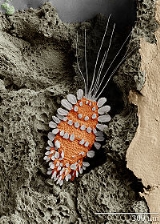
Peacock mite
Encyclopedia
The peacock mites are a significant pest in the tropics
, for example on citrus
fruit. It is the only genus
of the mite
family Tuckerellidae. Peacock mites are so named because of the elaborate ornamentations adorning the dorsal surface of their bodies . They also possess five to seven posteriorly projecting pairs of whip-like seta
e which are used to defend themselves against predators
. They may also help in wind-borne dispersal.
They are considered tetranychoid mites.
Tropics
The tropics is a region of the Earth surrounding the Equator. It is limited in latitude by the Tropic of Cancer in the northern hemisphere at approximately N and the Tropic of Capricorn in the southern hemisphere at S; these latitudes correspond to the axial tilt of the Earth...
, for example on citrus
Citrus
Citrus is a common term and genus of flowering plants in the rue family, Rutaceae. Citrus is believed to have originated in the part of Southeast Asia bordered by Northeastern India, Myanmar and the Yunnan province of China...
fruit. It is the only genus
Genus
In biology, a genus is a low-level taxonomic rank used in the biological classification of living and fossil organisms, which is an example of definition by genus and differentia...
of the mite
Mite
Mites, along with ticks, are small arthropods belonging to the subclass Acari and the class Arachnida. The scientific discipline devoted to the study of ticks and mites is called acarology.-Diversity and systematics:...
family Tuckerellidae. Peacock mites are so named because of the elaborate ornamentations adorning the dorsal surface of their bodies . They also possess five to seven posteriorly projecting pairs of whip-like seta
Seta
Seta is a biological term derived from the Latin word for "bristle". It refers to a number of different bristle- or hair-like structures on living organisms.-Animal setae:In zoology, most "setae" occur in invertebrates....
e which are used to defend themselves against predators
Predation
In ecology, predation describes a biological interaction where a predator feeds on its prey . Predators may or may not kill their prey prior to feeding on them, but the act of predation always results in the death of its prey and the eventual absorption of the prey's tissue through consumption...
. They may also help in wind-borne dispersal.
They are considered tetranychoid mites.
Species
- Tuckerella anommata Smith-Meyer & Ueckermann, 1997 (South Africa)
- Tuckerella channabasavannai Mallik & Kumar, 1992 (host: Saraca indicaSaracaSaraca L. is a genus in the family Fabaceae of about seventy plant species of tree native to the lands from India, China and Ceylon to Malaysia and Celebes....
; Andhra Pradesh) - Tuckerella eloisae Servin & Otero, 1989 (host: Fouquieria diguetiiFouquieriaFouquieria is a genus of 11 species of desert plants, the sole genus in the family Fouquieriaceae. The genus includes the ocotillo and the boojum tree or cirio . They have semi-succulent stems with thinner spikes projecting from them, with leaves on the bases spikes...
; Mexico) - Tuckerella filipina Corpuz-Raros, 2001 (parasite of Hydnocarpus anthelminticaHydnocarpusHydnocarpus is a genus of medium to large trees of Indonesia, Malaysia and the Philippines, having alternate leaves, small dioecious racemose flowers, and capsular fruits of which several are sources of chaulmoogra oil and hydnocarpus oil....
; Philippines) - Tuckerella hainanensis Lin & Fu, 1997 (host: Coffea arabicaCoffea arabicaCoffea arabica is a species of Coffea originally indigenous to the mountains of Yemen in the Arabian Peninsula, hence its name, and also from the southwestern highlands of Ethiopia and southeastern Sudan. It is also known as the "coffee shrub of Arabia", "mountain coffee" or "arabica coffee"...
; Hainan) - Tuckerella jianfengensis Lin & Fu, 1997 (host: Annona muricataAnnona muricataAnnona muricata is a member of the family of Custard apple trees called Annonaceae and a species of the genus Annona known mostly for its edible fruits Anona. Annona muricata produces fruits that are usually called Soursop due to its slightly acidic taste when ripe. A...
; Jianfengling) - Tuckerella kumaonensis Gupta, 1979 (India)
- Tuckerella litoralis Collyer, 1969
- Tuckerella nilotica Zaher & Rasmy, 1970
- Tuckerella ornatus (Tucker, 1926)
- Tuckerella xiamenensis Lin, 1982 (host: Manilkara zapota)
- Tuckerella xinglongensis Lin-Yanmou & Fu-Yuegua, 1997 (host: Polyscias fruticosaPolyscias fruticosaright|thumb|Polyscias guilfoylei and Polyscias fruticosaPolyscias fruticosa, or Ming Aralia, is a perennial dicot evergreen shrub or dwarf tree native to India. The plant grows fairly slowly but can reach up to 1 to 2 meters in height. The leaves are of a dark green pigment, glossy in texture, and...
var. plumata (AraliaceaeAraliaceaeAraliaceae is a family of flowering plants, also known as the Aralia family or Ivy family. The family includes 254 species of trees, shrubs, lianas and perennial herbaceous plants into 2 subfamilies...
), Hainan)

